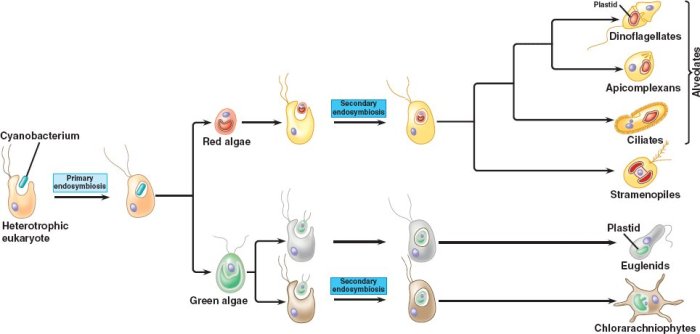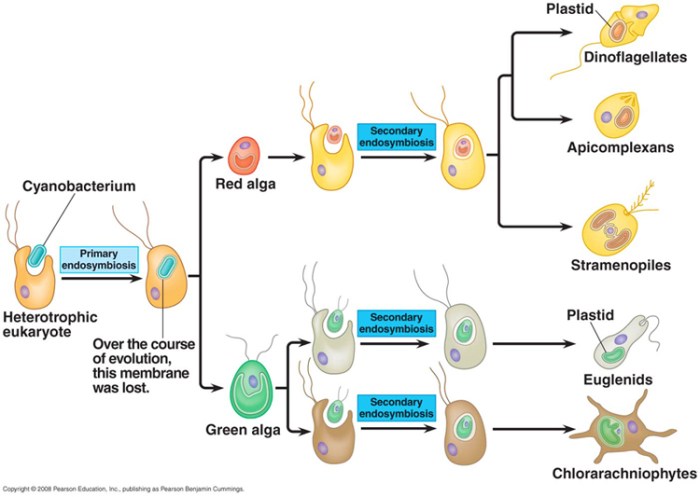Learning through art endosymbiosis of unicellular algae – Delving into the captivating world of learning through art, this discourse explores the novel and insightful approach of using art to elucidate the intricate concept of endosymbiosis in unicellular algae. This innovative method not only enhances understanding but also fosters creativity and engagement, making the learning process both enjoyable and impactful.
Endosymbiosis, a remarkable phenomenon where one organism resides within another, has played a pivotal role in cellular evolution. Unicellular algae, with their diverse characteristics and symbiotic relationships, offer a fascinating lens through which to explore this biological marvel. Through art, we can visualize and comprehend the intricate interactions between these organisms, gaining a deeper appreciation for the complexity of life.
Definition and Overview of Endosymbiosis
Endosymbiosis refers to a mutually beneficial relationship between two organisms, where one lives inside the other. This phenomenon has played a crucial role in cellular evolution, leading to the emergence of complex eukaryotic cells from simpler prokaryotic ancestors.
Examples of endosymbiotic relationships include the association between mitochondria and plants, where mitochondria provide energy for the plant cells, while the plant cells provide nutrients for the mitochondria.
Unicellular Algae and Endosymbiosis

Unicellular algae, such as green algae and diatoms, are key players in endosymbiotic relationships. These algae can form symbiotic partnerships with various organisms, including animals and protists.
For instance, the coral-algae symbiosis is a well-known example, where unicellular algae provide nutrients to corals through photosynthesis, while the corals offer protection and a stable environment for the algae.
Learning through Art: Endosymbiosis in Art: Learning Through Art Endosymbiosis Of Unicellular Algae

Art can be a powerful medium to convey complex scientific concepts like endosymbiosis. Visual representations of endosymbiotic relationships can enhance understanding and make the concept more accessible to learners.
For example, the artwork “Endosymbiosis” by the artist Lynn Margulis depicts the evolutionary history of eukaryotic cells through a series of symbolic images, illustrating the incorporation of bacteria into eukaryotic cells.
Methods for Teaching Endosymbiosis through Art
Incorporating art into teaching endosymbiosis can foster creativity and engagement. Here are some methods:
- Interactive Lesson Plan:Design a lesson plan that includes art activities, such as drawing or painting endosymbiotic relationships, to reinforce understanding.
- Illustrations and Diagrams:Create visually appealing illustrations or diagrams that clearly explain the process of endosymbiosis and the roles of different organisms involved.
- Student Art Exhibition:Organize a student art exhibition showcasing projects related to endosymbiosis, allowing students to express their understanding and creativity.
Benefits of Learning Endosymbiosis through Art

Using art to teach endosymbiosis offers several advantages:
- Enhanced Understanding:Visual representations can simplify complex concepts, making them easier to grasp.
- Creativity and Innovation:Art activities encourage students to think creatively and explore different perspectives.
- Engagement and Motivation:Incorporating art into learning can increase student engagement and motivation.
Future Directions and Applications

The use of art in teaching endosymbiosis has potential for further development:
- Innovative Art Forms:Explore new and innovative art forms to convey endosymbiotic relationships, such as digital art or immersive installations.
- Educational Programs:Integrate art into educational programs on endosymbiosis, creating a more engaging and interactive learning experience.
- Collaboration:Foster collaboration between artists and scientists to develop creative and informative artworks that promote understanding of endosymbiosis.
FAQ Overview
What are the key advantages of using art to teach endosymbiosis?
Art provides a tangible and engaging medium for visualizing complex biological concepts, enhancing comprehension and retention. It also fosters creativity, critical thinking, and collaboration among students.
How can art be incorporated into lesson plans on endosymbiosis?
Interactive activities such as creating diagrams, painting murals, or designing sculptures can bring endosymbiosis to life. These activities allow students to explore the topic from multiple perspectives and deepen their understanding.
What are some examples of successful art-based projects on endosymbiosis?
Student art exhibitions showcasing projects related to endosymbiosis have demonstrated the effectiveness of this approach. These projects have fostered a sense of ownership and pride in learning, leading to increased engagement and academic achievement.